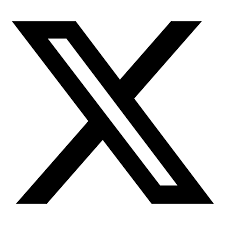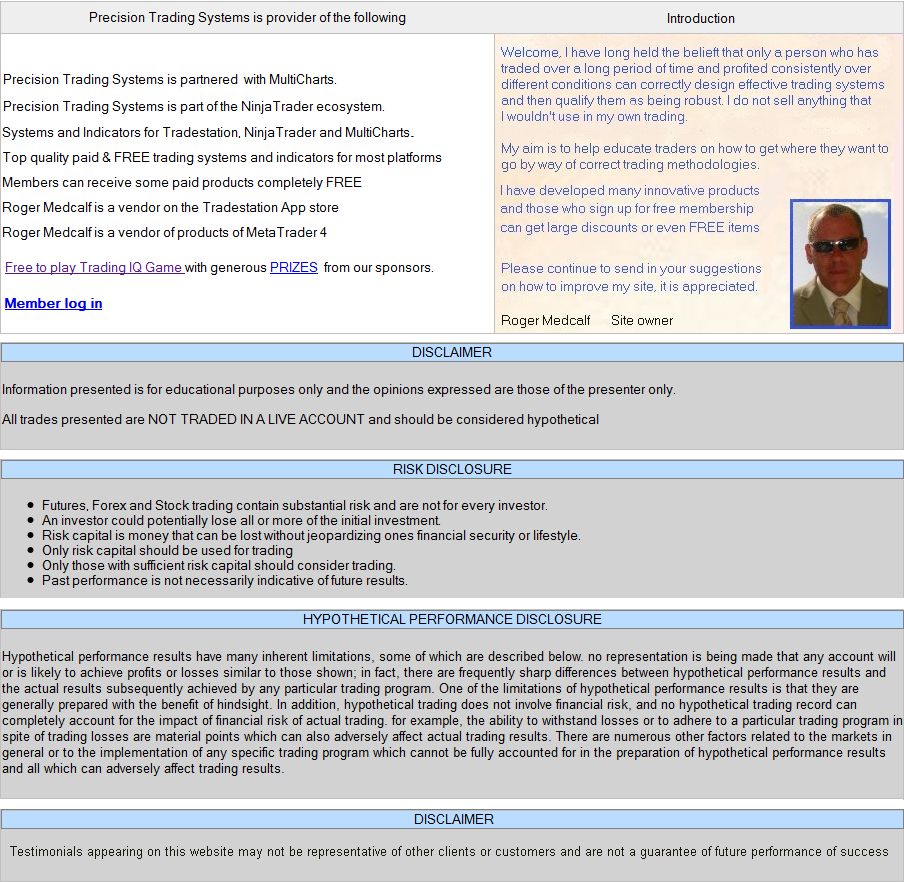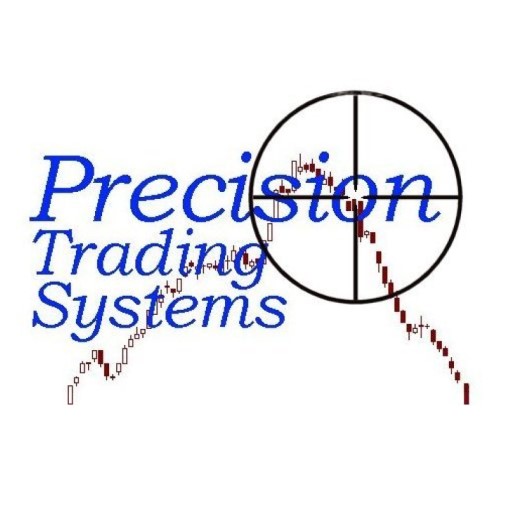
PTS-Precision Divergence Finder for Trading View
Designed to seek out bullish divergences that occur in the Demand Index Indicator over a multitude of different look back lengths
Tired of all the hard work seeking out nice bottoming v patterns for meaningful divergences? Let this product save your valuable time
Saves hours of time to find divergences in a rapid and precise manner. This divergence indicator for TradingView can save you MORE time
PTS-Precision Divergence Finder on speeded up data |
Tutorial Video Divergence indicators for TradingView
PTS-Precision Divergence Finder tutorial shows the effects of adjustment to the "Difference" factorNote big difference settings give more significant readings( But too big will give no readings ) |
|
There is a more detailed video user guide here shown on the MT4 plaform ( 3rd item down the page ) Please note the MetaTrader 4 version shown in this video used fine difference settings and this Trading View setting minimum is 1 |
Scroll down for disclaimer and payment buttons
Guidelines for using Precision Divergence Finder in Trading View
|
PTS Divergence Finder - otherwise known as Precision Divergence Finder. Description for Trading View useage |
|
The Precision Divergence Finder Indicator by Roger Medcalf of Precision Trading Systems. This product does best on markets with actual volume to function at its best. Risk control is essential and risking more than 1% to 1.5% of your capital from entry price to stop would not be advised. PTS Divergence Finder accurately measures the number of divergences which have occurred in Demand Index, which is a volume based indicator. This is a histogram style indicator for subgraph two, which plots spikes which appear like stalagmites coming up from the base. This product measures up to twenty divergences at once using multiple look back period up to a maximum of 200 bars. The Demand Index is called via the library file and the intelligent code sets volume to 1 if no volume is found. For this reason it will "work" (producing a meaningful plot) on Forex or indices without volume but performance is going to be slightly less than optimal as the valuable dimension of volume is missing. It is therefore best to focus on instruments like stocks and futures and cryptos that have large volumes and lots of participants. Liquid markets where many people are "voting" on the market direction give the best results. A total of twenty look back periods are scanned on every bar and these are hard coded non adjustable. The length of Demand Index is user adjustable but it is suggested not to wander too far below the default setting of length 20. The second user adjustable field is "difference" and this represents the difference between Demand Index now and Demand Index "N" bars ago. (N being 20 different look back periods) You will understand that a length 8 Demand Index produces a much more volatile plot than a 60 period plot. For this reason you can find short lengths of "DI" and small "difference" values will produce many more signals of divergences as there is higher volatility in the underlying indicator. You will observe this when you use it. You can set it to give hundreds of insignificant values but it is best used so you just see the significant ones by following the guidelines below. Consider this like using a 20 period MA on a 30 second chart compared to a 20 period MA on an hourly chart. The hourly MA change of direction is much more meaningful and important. Suggested settings for various lengths Di lengths less than 12 are not generally recommended for finding divergences DI Length 20 = difference of 7 - 15 DI Length 30 = difference of 5 - 10 DI Length 40 = difference of 4 - 9 DI Length 50 = difference of 2 - 7 DI Length 60 = difference of 1 - 5 DI Length 70 = difference of 1 - 4 You input manually smaller numbers such as 0.44 or 1.13 and these are worth testing if using long DI lengths above 100 up to 1000. DI Length maximum is 1000 As I designed this myself and have been using it for more than fifteen years you can trust me when I suggest to stay reasonably close to the default settings. Output relevance. The minimum value is zero which means there are no divergences found, you can then find values from 1 to 20 which is a count of the number of instances found. Paradoxically it is not so significance if the number is very high or very low as a major bottom occurring on a multi month low may just show a reading of 1 and some minor mid up trend dip might show a reading of 9. Be suspicious if you see too many large reading of 12 to 18 reoccurring as it is likely that the indicator is plotted on a market in a very long term and rapid decline. Execution of trades. Exercise caution with this product. Always always use a stop loss. Something like 3 to 7 times a fifty period average true range for example. Whilst it is often possible that a spike appears exactly at the precise low of the week or year and could be the only one you see all year it is risky just to buy it instantly as some markets produce several failed signals which continue lower. The safest and least risky method is to wait for the trend to begin rising after you see a divergence. This is subjective to your own definition of how to measure the trend as "rising" but I would suggest waiting for a 15-35 period Exponential average to turn upwards before buying. Once the trade is entered you can implement a trailing stop to allow maximum potential upside, and if your style is one of wanting to take quick profits, then it is wise to take only some partial profits and give the rally a chance to go higher and exit the remainder when the trend changes, which if the move was picked up near the absolute bottom could be a long time in an uptrend. Sometimes you might wait up to twenty five bars after the divergence is seen before the trend begins rising up. Much longer than this an it gradually negates the signal as it shows sellers have become stronger and the safest decision is to stay out of the market. It is not unusual for the divergences to mark the exact low of a market and this low can lead to a large move up. There are however frequent "failed divergences" and these can be treated in the same technical analysis manner as a failed head and shoulders or failed double bottom where the failure to rally indicates a likely hood of a continuation lower, meaning it is time to cut a loss. This indicator only gives buy signals. Every single signal will be given in some degree or another of degree of down trend at the lowest low price. Market selection is important. Avoid markets in an endless down trend. Best results are on liquid markets in a good long term up trends that has frequent dips, you can observe the past signals and often history repeats with a good previous signals tending to indicate that future signals may also be good. (This is not certain of course) This is also true of a market showing several historically bad divergence signals leading to more bad signals. If the past performance of this indicator is poor on the market you are viewing, then move to another market until one is found where the readings show good rallies after the signals in historical data. Time frames. This product can be applied to any time frame of market but be aware as is stated above, the slower time frames yield more valid signals and shorter time frames lead to more randomness and noise ridden plots of lower significance. That said it provides a valid reason to enter a trade and can give good results providing good stops and risk control are used. I have seen plenty of valid signals on 30 second charts right up to weekly charts. Idiosyncrasies. It can often be seen that multiple divergences occur over a range of ten to thirty bars during a very gentle spiky kind of price decline. This can be treated in the same way as above - waiting for the trend to rise after the last divergence occurs is the way to play it. Groups of divergences can indicate some patient insider buying patterns in anticipation of something they might know. Thanks for reading this and please read it a few more times to fully understand the points mentioned. After that please spend some time changing settings and markets to fully appreciate how it operates. What to expect Using this product you will see some spectaculor calls that pick the precise low of a big move up AND you will see signals that just plummet down. Seriously that is how it is. This is why stop losses are essential coupled with good risk management. |
|
Detailed additional information is provided on this pages Risk management in the sense of protection from market crashes with guidelines on stops to enter shorts. Optimal trade size for maximum gains Beginners and intermediate traders guide tutorial in six parts with examples diagrams and a few multiple choice questions |
Disclaimer
When purchasing this item you agree that you have read the disclaimer above |
||||||
|---|---|---|---|---|---|---|
|
|
The help and advice of customers and readers is valuable to me. Have a suggestion? Send it in!
The contact page here has my email address and you can search the site
If you
like what you see, feel free to
SIGN UP to be notified of new products - articles - less
than 10 emails a year and zero spam
Precision Trading Systems was founded in 2006
providing high quality indicators and trading systems for a wide range of
markets and levels of experience. Supporting NinjaTrader, Tradestation and
MultiCharts, TradingView and MetaTrader 4 and 5. ~ About ~




